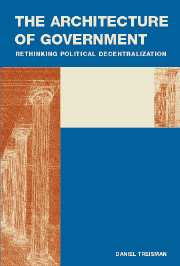Book contents
- Frontmatter
- Contents
- List of Figures and Tables
- Preface
- Glossary of Main Notation Used
- 1 INTRODUCTION
- 2 THE POLITICAL PROCESS
- 3 ADMINISTRATIVE EFFICIENCY
- 4 COMPETITION AMONG GOVERNMENTS
- 5 FISCAL POLICY AND REDISTRIBUTION
- 6 FISCAL COORDINATION AND INCENTIVES
- 7 CITIZENS AND GOVERNMENT
- 8 CHECKS, BALANCES, AND FREEDOM
- 9 ACQUIRING AND USING KNOWLEDGE
- 10 ETHNIC CONFLICT AND SECESSION
- 11 DATA TO THE RESCUE?
- 12 CONCLUSION: RETHINKING DECENTRALIZATION
- References
- Index
- Titles in the series
10 - ETHNIC CONFLICT AND SECESSION
Published online by Cambridge University Press: 05 June 2012
- Frontmatter
- Contents
- List of Figures and Tables
- Preface
- Glossary of Main Notation Used
- 1 INTRODUCTION
- 2 THE POLITICAL PROCESS
- 3 ADMINISTRATIVE EFFICIENCY
- 4 COMPETITION AMONG GOVERNMENTS
- 5 FISCAL POLICY AND REDISTRIBUTION
- 6 FISCAL COORDINATION AND INCENTIVES
- 7 CITIZENS AND GOVERNMENT
- 8 CHECKS, BALANCES, AND FREEDOM
- 9 ACQUIRING AND USING KNOWLEDGE
- 10 ETHNIC CONFLICT AND SECESSION
- 11 DATA TO THE RESCUE?
- 12 CONCLUSION: RETHINKING DECENTRALIZATION
- References
- Index
- Titles in the series
Summary
Where major ethnic or regional cleavages exist that are territorially based, the relationship is by now self-evident and axiomatic: The absence of provisions for devolution and decentralization of power, expecially in the context of ethnoregional disparities, feeds ethnic insecurity, violent conflict, and even secessionist pressures. … In deeply divided societies, meaningful devolution of power – typically through federalism – is an indispensable instrument for managing and reducing conflict.
Larry Diamond, Juan Linz, and Seymour Martin Lipset, (1995, pp. 44–5)Federalism has become a very popular “solution” for problems of ethnic conflict in public discourse. In fact, ethnic federations are among the most difficult of all to sustain and are least likely to survive because constituent units based on ethnic nationalisms normally do not want to merge into the kind of tight-knit units necessary for federation.
Daniel Elazar (1993, p. 194)As American-occupied Iraq slid into civil war in 2004–5, experts debated what political arrangements might contain the escalating sectarian violence. Many saw the best hope in the creation of a loose federation or some other kind of decentralized order. According to Dawn Brancati (2004, p. 7), writing in early 2004: “federalism offers the only viable possibility for preventing ethnic conflict and secessionism as well as establishing a stable democracy in Iraq.” Around the same time, Larry Diamond (2004) predicted that: “Federalism – as negotiated and structured by Iraqis in their process of constitution making during the coming year – will provide the means to hold Iraq together permanently, democratically, and peacefully.
- Type
- Chapter
- Information
- The Architecture of GovernmentRethinking Political Decentralization, pp. 236 - 246Publisher: Cambridge University PressPrint publication year: 2007



